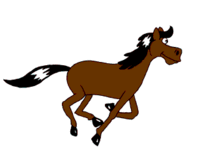10. Animation
Before video came along, animation was the only way to provide the illusion of movement.
Have you ever made a 'flick-book' ? Where you have a ream of paper and add a slighlty different image to each sheet. Then you riffle through the paper and the images you have drawn appear to move. This is the most basic animation.
These days, the 'flick-book' is replaced with 'animated gifs', where every frame is slightly different so as they run through, the images appear to move.
But even in the video age, animations have their place because they seem to simplify the message being conveyed compared to 'real-life' video.
Here is an example of a fairly simple animation: |
 |
This animation is far more complicated. This type of animation can be used to convey complex information in a way that would be difficult with text or a static image. It provides the viewer with a visual understanding of the 3D construction of the molecule. |
 |
Animation has been growing in popularity as a method of conveying information to others.
The availability of software such as 'Flash' has enabled many people to create animations to educate, inform, entertain or advertise.
challenge see if you can find out one extra fact on this topic that we haven't already told you
Click on this link: Educational Animation
